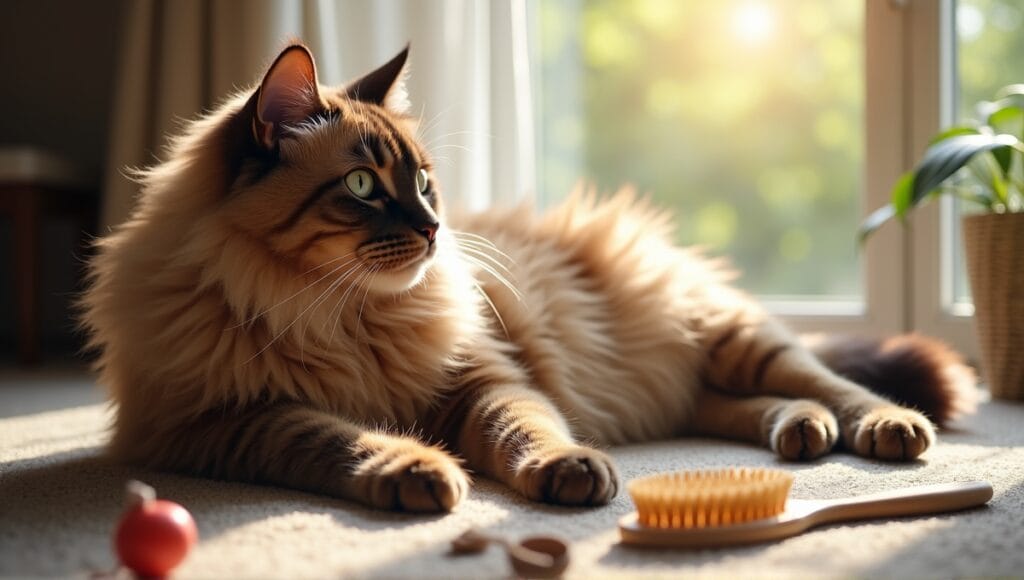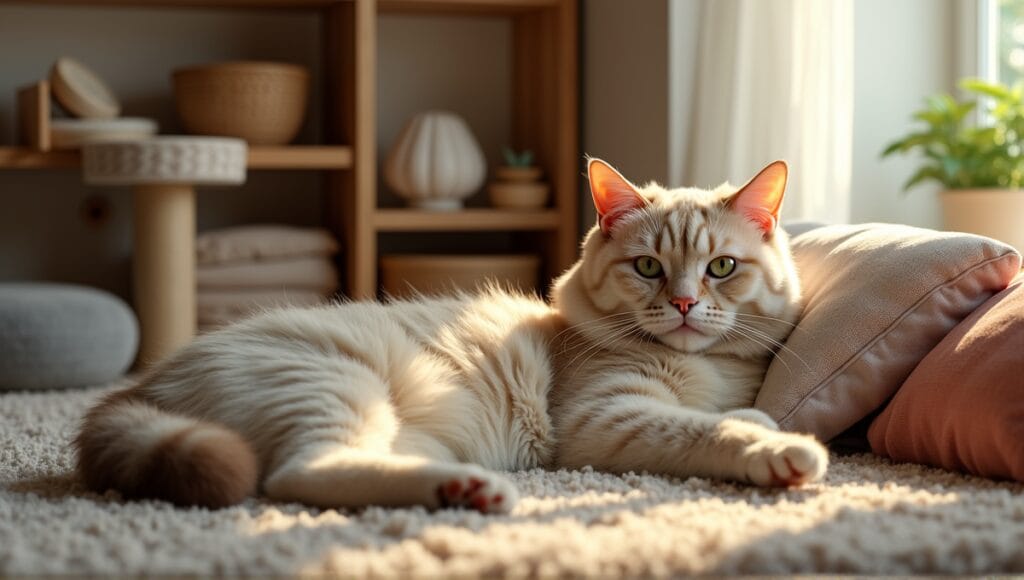I’ve been obsessed with cat breeds since I was a little girl, and the largest cat breeds have always captivated me. These massive cats are some of the greatest giants in the world of cats. However, they are so much more than just their enormous size. In this section, you’ll learn why Maine Coons, Savannah cats, and Ragdolls are some of the largest cats by weight.
We’ll also discuss their special attributes, any health issues to be aware of, and how to care for them. If you’re thinking about getting a large cat breed, you’re in luck!
Understanding Heavy Cat Breeds
Cat breeds vary significantly in size. Some are small and dainty, while others are quite large. Heavy cat breeds are those that are typically heavier than the average cat. These cats often weigh 15 pounds or more. However, their size isn’t just about weight. Many of these breeds have a long body, a muscular build, or thick, voluminous fur.
A variety of factors contribute to a cat’s size and weight. Genetics play a huge role. Certain breeds simply have a genetic predisposition to being larger. Diet and exercise also impact a cat’s weight. Overfeeding or lack of exercise can lead to a cat being overweight, even if it isn’t a naturally heavy breed.
Owning a heavy cat can be a unique experience. These cats are often some of the most affectionate and loving cats. However, owning a heavy cat does present some challenges. Heavy cats need more space to move around comfortably. They also eat more, so can be slightly more costly to own. Additionally, they may need a slightly larger litter box.
Proper care is essential for heavy cat breeds. They should be fed a high-quality, well-balanced diet that’s appropriate for their size and activity level. Regular exercise is also important to keep them from becoming overweight, which can cause stress and strain on their joints. Finally, heavy cats need furniture that’s sturdy enough to support their weight.
As someone who loves cats and has worked with them for years, I can’t emphasize enough how important it is to provide these things for your heavy cat. If you’re interested in exotic cat breeds, some of which can be quite large, it’s important to research their specific needs.
Top 5 Heaviest Cat Breeds

- Maine Coon
- Can weigh 18 pounds or more
- Long rectangular body
- Distinctive ear tufts and lynx-like tips
- Friendly and social
- Savannah
- Hybrid breed that can weigh 20 pounds
- Tall, slender, spotted coats
- Extremely active and intelligent
- Needs a lot of mental and physical stimulation
- Ragdoll
- Males weigh 15-20 pounds
- Large blue eyes and color-point coats
- The breed flops when relaxed
- Gentle and affectionate
- Siberian
- Typically weighs 15-20 pounds
- Triple coat that’s water-resistant
- Strong hind legs
- Playful and good with kids
- Norwegian Forest Cat
- Can weigh up to 16 pounds
- Double coat
- Muscular body and tufted paws
- Independent and affectionate
I worked in a pet store, and I’ve seen all of these breeds. Each one has something special about it. The Maine Coon is often a lot more gentle than people expect given its size. Savannahs feel like you have a mini leopard in your house. Ragdolls are true to their name with how relaxed they are.
Siberians often look intimidating, but they are usually very friendly. Norwegian Forest Cats are always impressive with their coats and sturdy bodies. Keep in mind these are average weights, and a cat can definitely weigh more or less depending on its genetics and lifestyle. If you’re considering a bengal cat, which is another larger breed, it’s important to understand their unique characteristics and needs.
Characteristics of Heavy Cat Breeds

Most heavy cat breeds all share similar physical characteristics. They tend to have large, sturdy bodies. They can weigh anywhere from 15 to well over 20 pounds. Many of them have long, rectangular bodies with a sturdy, muscular appearance. Some breeds, like the Maine Coon and Norwegian Forest Cat, also have thick, fluffy coats, which makes them look even larger.
The temperament of heavy breeds can vary quite a bit. Many are gentle giants with a laid-back attitude who enjoy lounging around with their human. Others, like the Savannah, are more active and playful. These cats will require more interactive play and engagement.
Heavy breeds often have higher grooming requirements, particularly those with long coats. Some heavy breeds will require daily brushing to prevent matting and reduce shedding. A breed of cats like the Siberian, for example, has a water resistant coat that requires less frequent baths. Regardless, most heavy breeds need their nails trimmed regularly as the extra weight puts added strain on their nails.
The activity level of heavy breeds can also vary. Some are perfectly content with regular play, while others need more exercise. Providing climbing trees, scratching posts, and interactive toys is important to help them stay at a healthy weight and keep them mentally stimulated. Even the largest of cat breeds still seem to enjoy basic toys like feather wands or crinkle balls. For those interested in long-haired cat breeds, many of which can be on the heavier side, it’s important to consider their grooming needs.
Health Considerations for Heavy Cat Breeds
Heavy cat breeds are more prone to specific health problems. Joint issues, such as hip dysplasia and arthritis, are common due to their size. Heart problems are also a concern, particularly in breeds like the Maine Coon. Many heavy breeds are predisposed to hypertrophic cardiomyopathy, a serious heart condition.
Regular vet check-ups are essential for heavy cat breeds. These visits will ensure any health issues are caught early. Your vet can also keep an eye on your cat’s weight and joint health. Depending on your cat’s breed and age, your vet may recommend specific tests or check-ups.
Proper nutrition is essential for heavy cat breeds. You need to feed them a balanced diet that supports their size without causing excessive weight gain. High-quality protein is important to maintain muscle mass. Portion sizes are also important to prevent obesity, which will only make joint problems worse.
Preventing joint issues will be a focus throughout your heavy cat breed’s life. Your vet may recommend supplements such as glucosamine. You can also make your cat more comfortable by providing cozy sleeping spots and easy access to their favorite high perches. Some heavy cat owners also invest in orthopedic beds for their cats.
Caring for Heavy Cat Breeds

Feeding larger cat breeds takes some consideration. They require a high-protein diet to support their larger muscle mass. It’s important to practice portion control so they don’t become overweight. Instead of feeding all their daily food at once, break it up into several smaller meals to reduce overeating and alleviate stress on their digestive system.
Exercise is essential for larger cats, but remember to keep it at a level that is manageable for them. Interactive play with wand toys or laser pointers is effective. Puzzle feeders work well for mental stimulation and to get them moving. Some larger breeds of cats enjoy climbing, so investing in a cat tree or wall mounted shelves can help.
Grooming needs depend on the breed’s coat length. Longhaired breeds may need daily brushing to prevent mats. Shorthaired breeds still benefit from regular grooming to minimize shedding and create a bonding opportunity. Be sure to brush areas of the cat that might be more difficult for a large cat to groom, such as its lower back.
Larger cat breeds require an appropriate living environment. Invest in sturdy furniture and perches that won’t break. Purchase larger scratching posts. Have several comfortable resting places throughout your house. Make sure the litter boxes are large enough. If you’re considering mixed breed cats, which can sometimes be larger depending on their parentage, it’s important to be prepared for a range of potential sizes and care needs.
Other Notable Heavy Cat Breeds

Chausie:
- Can weigh up to 30 pounds
- Lean, athletic body with long legs
- Often described as “dog-like”
- Very high energy – needs plenty of play space
British Shorthair:
- Males can weigh up to 17 pounds
- Round, chubby face
- Calm and laid-back
- Low maintenance – short, dense coat
Pixie-bob:
- Can weigh up to 17 pounds
- Wild appearance (spotted coat)
- Often polydactyl
- Smart and enjoys interactive play
Each of these breeds has different qualities. Chausies are extremely active and require plenty of room to play. British Shorthairs are more relaxed yet still a large breed (size). Pixie-bobs look wild, but most are very loving with their families.
These overweight cat breeds all have distinct personalities. Chausies are extremely active and need a lot of space to play. British Shorthairs are more relaxed and definitely more mellow. Pixie-bobs look wild, and most are very sweet with their families.
In my experience with different cat breeds, these big cats often defy expectations with their behavior. They may look intimidating, but many of them are sweet cats. With the right care and knowledge of their needs, they can make great pets. For those interested in friendly cat breeds, many of these larger breeds are known for their affectionate nature.
Parting Thoughts
Large cat breeds are wonderful animals, but they do require some extra care and attention due to their size and specific needs. From Maine Coons to Norwegian Forest Cats, these gentle giants make great pets and provide lots of love and companionship. Providing the right food, exercise, and regular vet check-ups are all important to keep them healthy, and with proper care, you’ll enjoy a loyal, loving feline companion for many years.
Of course, every cat is an individual, so your particular large breed cat may have unique quirks and care requirements. Pay attention to your cat’s behavior and health, and adjust your care strategy accordingly. The bond you’ll build with your large cat will be very rewarding.






